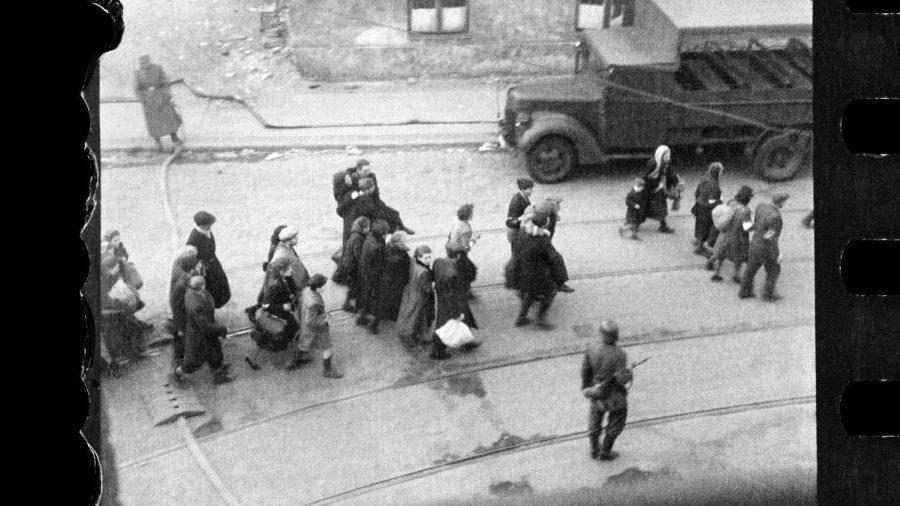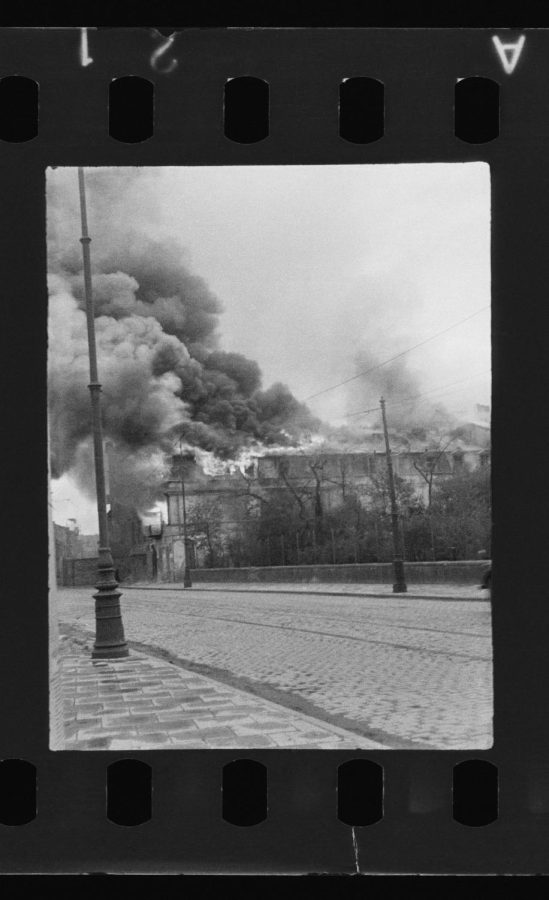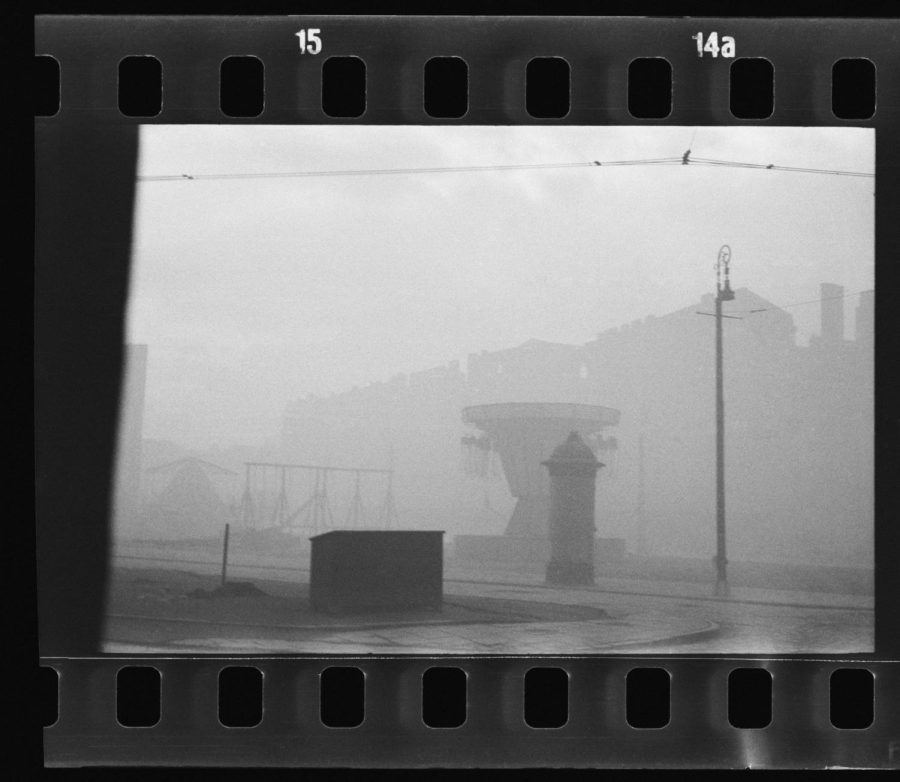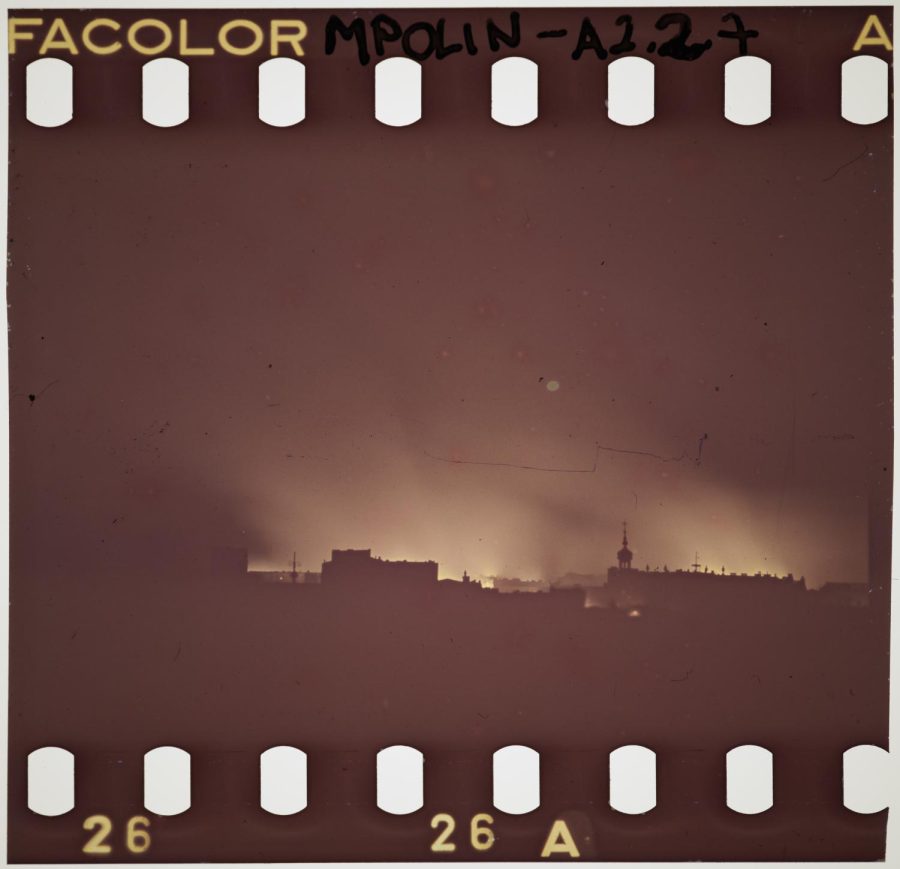A look at never-before-seen Warsaw Ghetto Uprising photos
Jews being led to Umschlagplatz; photo taken from a window of St Zofia Hospital at the corner of Żelazna and Nowolipie Streets, most likely (to be confirmed) overlooking Nowolipie Street; author’s comment noted after the war at the back of the print held in the USHMM archive in Washington, DC: ”Scenes from the evacuation of the ghetto, ca 20 April 1943” Photo: Z. L. Grzywaczewski / from the family archive of Maciej Grzywaczewski, son of Leszek Grzywaczewski / scan of the negative: POLIN Museum, Archaeology of Photography Foundation
Published April 16, 2023
April 19, 2023, marks the 80th anniversary of the outbreak of the Warsaw Ghetto Uprising. On that day in 1943, on the eve of Passover, 50,000 people were still imprisoned in the area of the Warsaw ghetto—among them 20-year old Mietek Pachter, 21-year old Mira Piżyc and 11-year old Helena Kuczer (Krystyna Budnicka). They were not fighters, just like very many others in the ghetto. And yet, their silent resistance was just as important as participating in armed combat.
What happened to the tens of thousands of people who descended to underground bunkers during the uprising and remained unreachable for many days is the focus of a new exhibit at the POLIN Museum of the History of Polish Jews in Warsaw.
Noting the importance of the exhibit and the fact that few in St. Louis will be able to travel to Warsaw in the near future, the Jewish Light is taking advantage of the press materials and photographs made available by the POLIN Museum to recreate a portion of the exhibit here, digitally.
ADVERTISEMENT
Around Us A Sea Fire
The exhibit, “Around Us a Sea of Fire. The fate of Jewish civilians during the Warsaw Ghetto Uprising” opens April 18, on the eve of the 80th anniversary of the outbreak of the Warsaw Ghetto Uprising. The exhibit will, for the first time ever, tell the untold story of the uprising from the perspective of the civilians who were hiding inside the ghetto.
“We wanted to recall the memory of the nearly 50,000 people who did not belong to underground organizations in the ghetto and didn’t fight with arms in their hands,” said Zuzanna Schnepf-Kołacz, the exhibition curator. “They remained in hiding—that was their act of resistance against the liquidation of the ghetto. We wish to convey the feelings and emotions of the people who defied German orders to turn up for collections—back then it was obvious to all deportations meant death—and instead retreated to the basements and bunkers.”
Added Professor Barbara Engelking, author of the exhibition, “They hid in bunkers and shelters. Their silent act of resistance was as important as armed combat.”
ADVERTISEMENT
Engelking and Schnepf-Kołacz focused on the experience of the civilians described in their diaries or notes taken during the uprising or immediately after its suppression. Words are all that has survived, the only trace left of these people.
“Thanks to these words, we will recall the memory of an anonymous author who hid in the bunker in the vicinity of 44 Miła Street, of lab technician Stella Fidelseid who gave birth to a baby boy in the bunker, of 17-year old Leon Najberg who returned to the ghetto once he’d heard the uprising was about to break out,” said Engelking.
Photos discovered after decades
The exhibition will show two sets of photographs, together with original plates, which found their way to the POLIN Museum and the exhibition, almost at the last minute. The first is a set of photographs was taken during the Warsaw Ghetto Uprising by Zbigniew Leszek Grzywaczewski, who worked in the Warsaw Fire Brigade during the war. A total of 48 shots were recorded on the film, 33 of which depict the ghetto. Here are six that the museum released.
Photo: Z. L. Grzywaczewski / from the family archive of Maciej Grzywaczewski, son of Leszek Grzywaczewski / scan of the negative: POLIN Museum, Archaeology of Photography Foundation
These are photos depicting the smoke over the ghetto as well as in the streets and courtyards inside the ghetto, burnt-out houses, firefighters putting out the flames, posing on the roof of a building or eating from mess tins in the street. Many images are repeated, especially those of the burning buildings, the ghetto wall and people being led to Umschlagplatz.
“It seems that Leszek Grzywaczewski tried his best to record these scenes, realizing the importance of documenting events inaccessible to the eyes of people on the other side of the ghetto wall,” said Marta Dziewulska, POLIN Museum press officer. “This is the only photographic film that historians of the Holocaust know of which shows the images inside the ghetto. These are unique photos taken by a Pole—not by the German perpetrators who wanted to show the Jews in the worst possible way. The German photos were used for propaganda, such as the report prepared by Jurgen Stroop for Heinrich Himmler.”
Another set of photos and the accompanying negatives were brought to POLIN Museum by Aleksandra Sobiecka, granddaughter of Rudolf Damec. Damec, was a 34-year-old Polish engineer. The pictures he took showed the ghetto burning during the Uprising and passers-by looking at it—are very few and far between.
Damec gets up close not only to the ghetto wall, but also to the people looking at the ghetto burning behind the wall. You can see their faces, their gestures, their facial expressions, the details of their clothing; we see children, adults, some dressed elegantly, some modestly. We are presented with an image of a world that existed simultaneously to the Holocaust taking place behind the ghetto wall.
Here are some additional photos from the exhibit.
The museum is planning a wide selection of events to accompany the Warsaw Ghetto Uprising Campaign and the program around the “Thou Shalt Not Be Indifferent. 80th anniversary of the Warsaw Ghetto Uprising” commemoration, to be held through April 22. You can read and see more online.
| RELATED: How to honor and learn about the unsung heroines of the Warsaw Ghetto Uprising




















